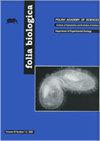Evidence for the Existence of Two Prolactin Isoforms in the Developing Pituitary Gland of the Goose (Anser cygnoides)
IF 0.8
4区 生物学
Q4 BIOLOGY
引用次数: 1
Abstract
Compared to Galliformes such as chicken and turkey, very little is known about the existence and expression of isoforms of prolactin (PRL) in the pituitary glands of Anseriformes. In this study, by generating a rabbit-anti-goose (Anser cygnoides) PRL polyclonal antibody, we analysed the expression patterns of goose PRL isoforms in the embryonic and post-hatch development of the pituitary gland. Our results showed that two immunoreactive bands with molecular weights of about 23 and 26 kDa were detected using the Western blot technique, corresponding to the non-glycosylated (NG-) and the glycosylated (G-) isoform of PRL, respectively. The protein levels of the total PRL in a goose increased gradually from the embryonic day (ED) 22 to the post-hatch day (PD) 28, with a non-significant decrease on PD6. Furthermore, the percentage of G-PRL in the pituitary gland of the goose fluctuated from about 30.3% to 54.7% throughout the embryonic and post-hatch development. At the mRNA level, the expression of PRL increased steadily during the development and reached the highest levels on PD12, but later showed a non-significant decrease on PD28. The inconsistent expression patterns between the PRL mRNA and protein during the stages from PD6 to PD28 indicated that the PRL gene expression involves both transcriptional and post-translational regulation. Taken together, our data unequivocally demonstrated the existence of NG- and G-PRL in the pituitary gland of a goose and that the expression of the total PRL as well as the percentage of G-PRL significantly changed during embryonic and post-hatch development, indicating that the versatile biological functions of PRL during the ontogenesis of a goose could be closely related to changes in both its total expression and the degree of glycosylation in the pituitary gland.鹅脑垂体发育中两种催乳素异构体存在的证据
与鸡和火鸡等Galliformes相比,人们对Anseriformes垂体中催乳素(PRL)亚型的存在和表达知之甚少。在本研究中,通过产生兔抗鹅PRL多克隆抗体,我们分析了鹅PRL亚型在垂体胚胎和孵化后发育中的表达模式。我们的结果表明,使用蛋白质印迹技术检测到两个分子量约为23和26kDa的免疫反应带,分别对应于PRL的非糖基化(NG-)和糖基化的(G-)亚型。鹅总PRL的蛋白质水平从胚胎第22天(ED)到孵化后第28天(PD)逐渐增加,而PD6的蛋白质水平没有显著下降。此外,在整个胚胎和孵化后的发育过程中,鹅垂体中G-PRL的百分比在约30.3%至54.7%之间波动。在mRNA水平上,PRL的表达在发育过程中稳步增加,在PD12上达到最高水平,但后来在PD28上没有显著下降。在从PD6到PD28的阶段,PRL mRNA和蛋白质之间不一致的表达模式表明PRL基因的表达涉及转录和翻译后调控。总之,我们的数据明确证明了鹅垂体中存在NG-和G-PRL,并且在胚胎和孵化后发育过程中,总PRL的表达以及G-PRL的百分比发生了显著变化,表明PRL在鹅个体发生过程中的多种生物学功能可能与其在垂体中的总表达和糖基化程度的变化密切相关。
本文章由计算机程序翻译,如有差异,请以英文原文为准。
求助全文
约1分钟内获得全文
求助全文
来源期刊

Folia Biologica-Krakow
医学-生物学
CiteScore
1.10
自引率
14.30%
发文量
15
审稿时长
>12 weeks
期刊介绍:
Folia Biologica (Kraków) is an international online open access journal accepting original scientific articles on various aspects of zoology: phylogeny, genetics, chromosomal studies, ecology, biogeography, experimental zoology and ultrastructural studies. The language of publication is English, articles are assembled in four issues per year.
 求助内容:
求助内容: 应助结果提醒方式:
应助结果提醒方式:


